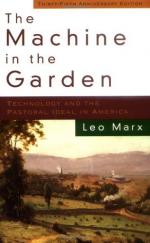
|
| Name: _________________________ | Period: ___________________ |
This test consists of 15 multiple choice questions and 5 short answer questions.
Multiple Choice Questions
1. What were Beverly's sources for his history of Virginia?
(a) The sea captains' log books.
(b) The King's records.
(c) Nautical charts.
(d) The settlers' notes and journals.
2. What did Hawthorne describe in the piece Marx analyzed?
(a) A whale hunt.
(b) Indian wars.
(c) A reverie in the woods.
(d) Living in the woods.
3. How have the relationships between the city and country changed in American industrial pastoralism?
(a) They are no longer interdependent.
(b) They are both monetized.
(c) They are both reinvented by machines.
(d) They are no longer exclusive.
4. What does pastoral ideology conflict with, in Marx's account?
(a) Industrial modernism.
(b) Extractive industries.
(c) Urbanization.
(d) The reality of history.
5. How did Arthur Barlowe describe America?
(a) As a tropical paradise.
(b) As a land of plenty.
(c) As a harsh land.
(d) As a refuge from Europe.
6. What would people live on, in Gonzalo's ideal world?
(a) Nature's bounty.
(b) Money from exports.
(c) Imported grain.
(d) Natives' produce.
7. What virtues did Jefferson associate with the civilization?
(a) Creativity and inspiration.
(b) Ingenuity and technology.
(c) Creativity and inspiration.
(d) Intellect and privilege.
8. What did the settlers find appealing about the New World?
(a) Everything was free for the taking.
(b) It was unsoiled by civilization.
(c) It was theirs by right of conquest.
(d) They could buy land so cheap from the natives.
9. What does Marx say Beverly felt about the New World, by the end of his history?
(a) Elated.
(b) Disappointed.
(c) Cautiously optimistic.
(d) Determined.
10. How did the first settlers see Virginia, in Beverly's history?
(a) As a promised land.
(b) As a desert.
(c) As a pestilential swamp.
(d) As a purgatory.
11. How had feelings about nature changed by Jefferson's time?
(a) Nature seemed benevolent compared with the disordered city.
(b) Nature seemed divine and benevolent compared with corrupt man.
(c) Nature had become a mirror for man's corrupt soul.
(d) Nature seemed chaotic and devilish compared with civilization.
12. What does the end of Shakespeare's 'The Tempest' demonstrate, in Marx's interpretation?
(a) Balance between men and women.
(b) Fairness in dividing territory.
(c) Balance between man and nature.
(d) Justice in righting old wrongs.
13. Where was Hawthorne when he wrote the piece Marx analyzed?
(a) Yosemite, CA.
(b) Providence, RI.
(c) Concord, MA.
(d) Norfolk, VA.
14. When did complex pastoral ideology come into existence?
(a) Twentieth century.
(b) With colonization.
(c) Nineteenth century.
(d) Eighteenth century.
15. What was Jefferson's ideal of equality democracy founded on?
(a) Fostering entrepreneurship.
(b) A government that encouraged self-reliance.
(c) The free market.
(d) Protecting individuals from industrialism.
Short Answer Questions
1. What is the second stage of life that Marx describes through Shakespeare's 'The Tempest'?
2. When did the assault on American pastoralism begin, in Marx's account?
3. What do Americans abandon when they are under the influence of the sentimental pastoral ideal?
4. How does Marx describe the encroachment of industrialism?
5. What piece by Nathaniel Hawthorne does Marx treat as emblematic of American pastoralism?
|
This section contains 483 words (approx. 2 pages at 300 words per page) |

|




